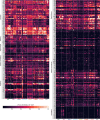This is a preprint.
Classification of psychedelics and psychoactive drugs based on brain-wide imaging of cellular c-Fos expression
- PMID: 38826215
- PMCID: PMC11142187
- DOI: 10.1101/2024.05.23.590306
Classification of psychedelics and psychoactive drugs based on brain-wide imaging of cellular c-Fos expression
Update in
-
Classification of psychedelics and psychoactive drugs based on brain-wide imaging of cellular c-Fos expression.Nat Commun. 2025 Feb 12;16(1):1590. doi: 10.1038/s41467-025-56850-6. Nat Commun. 2025. PMID: 39939591 Free PMC article.
Abstract
Psilocybin, ketamine, and MDMA are psychoactive compounds that exert behavioral effects with distinguishable but also overlapping features. The growing interest in using these compounds as therapeutics necessitates preclinical assays that can accurately screen psychedelics and related analogs. We posit that a promising approach may be to measure drug action on markers of neural plasticity in native brain tissues. We therefore developed a pipeline for drug classification using light sheet fluorescence microscopy of immediate early gene expression at cellular resolution followed by machine learning. We tested male and female mice with a panel of drugs, including psilocybin, ketamine, 5-MeO-DMT, 6-fluoro-DET, MDMA, acute fluoxetine, chronic fluoxetine, and vehicle. In one-versus-rest classification, the exact drug was identified with 67% accuracy, significantly above the chance level of 12.5%. In one-versus-one classifications, psilocybin was discriminated from 5-MeO-DMT, ketamine, MDMA, or acute fluoxetine with >95% accuracy. We used Shapley additive explanation to pinpoint the brain regions driving the machine learning predictions. Our results support a novel approach for characterizing and validating psychoactive drugs with psychedelic properties.
Keywords: MDMA; Psilocybin; antidepressant; drug discovery; entactogen; immediate early gene; ketamine; neural plasticity.
Conflict of interest statement
Competing interests A.C.K. has been a scientific advisor or consultant for Boehringer Ingelheim, Empyrean Neuroscience, Freedom Biosciences, and Psylo. A.C.K. has received research support from Intra-Cellular Therapies. A.P.K has received research support from Transcend Therapeutics and Freedom Biosciences. A.P.K. has a provisional patent application related to psychedelics. The other authors report no financial relationships with commercial interests.
Figures






Similar articles
-
Classification of psychedelics and psychoactive drugs based on brain-wide imaging of cellular c-Fos expression.Nat Commun. 2025 Feb 12;16(1):1590. doi: 10.1038/s41467-025-56850-6. Nat Commun. 2025. PMID: 39939591 Free PMC article.
-
Shared and Distinct Brain Regions Targeted for Immediate Early Gene Expression by Ketamine and Psilocybin.ACS Chem Neurosci. 2023 Feb 1;14(3):468-480. doi: 10.1021/acschemneuro.2c00637. Epub 2023 Jan 11. ACS Chem Neurosci. 2023. PMID: 36630309 Free PMC article.
-
5-MeO-DMT modifies innate behaviors and promotes structural neural plasticity in mice.Neuropsychopharmacology. 2023 Aug;48(9):1257-1266. doi: 10.1038/s41386-023-01572-w. Epub 2023 Apr 4. Neuropsychopharmacology. 2023. PMID: 37015972 Free PMC article.
-
Registered clinical studies investigating psychedelic drugs for psychiatric disorders.J Psychiatr Res. 2021 Jul;139:71-81. doi: 10.1016/j.jpsychires.2021.05.019. Epub 2021 May 18. J Psychiatr Res. 2021. PMID: 34048997 Review.
-
Role of Psychedelics in Treatment-Resistant Depression.Psychiatr Clin North Am. 2023 Jun;46(2):291-305. doi: 10.1016/j.psc.2023.02.004. Epub 2023 Mar 25. Psychiatr Clin North Am. 2023. PMID: 37149346 Review.
References
-
- Vollenweider FX, Preller KH. Psychedelic drugs: neurobiology and potential for treatment of psychiatric disorders. Nat Rev Neurosci 21, 611–624 (2020). - PubMed
-
- Carhart-Harris R, et al. Trial of Psilocybin versus Escitalopram for Depression. N Engl J Med 384, 1402–1411 (2021). - PubMed
-
- Goodwin GM, et al. Single-Dose Psilocybin for a Treatment-Resistant Episode of Major Depression. N Engl J Med 387, 1637–1648 (2022). - PubMed
Publication types
Grants and funding
LinkOut - more resources
Full Text Sources
